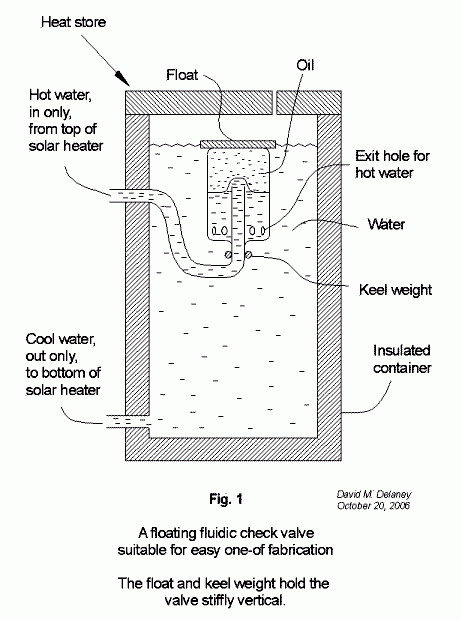Check valves for entirely passive solar water heaters
.
A check valve, or one-way valve, permits flow in one direction only.
Certain solar water heating systems require a check valve to prevent a
reverse (cooling) flow through the solar water heater when the heater
is cold.
A check valve for an entirely passive solar water heating system must
be very sensitive. In an entirely passive solar water heating system,
water can move through the solar water heater only by natural
convection – a movement produced only by the small difference in
gravitational force due to the density difference between warmer and
cooler parts of the water.
 Shawn Buckley invented a particularly sensitive fluidic
check valve while
inventing a modular solar heat collector/heat store, the thermic
diode. A fluidic check valve for water uses an auxiliary fluid, for
example,
oil, that differs slightly from water in density. The two fluids
are the only moving parts of a fluidic check valve. Buckley claimed the
fluidic check
valve in U.S. patent 4,245,617 (1981). The
thermic diode and its fluidic check valve are described less formally in Chapter 23 of Buckley's book, Sun Up to Sun Down, 1979, McGraw-Hill, ISBN 0-07-008790-3, pp. 133-137.
Shawn Buckley invented a particularly sensitive fluidic
check valve while
inventing a modular solar heat collector/heat store, the thermic
diode. A fluidic check valve for water uses an auxiliary fluid, for
example,
oil, that differs slightly from water in density. The two fluids
are the only moving parts of a fluidic check valve. Buckley claimed the
fluidic check
valve in U.S. patent 4,245,617 (1981). The
thermic diode and its fluidic check valve are described less formally in Chapter 23 of Buckley's book, Sun Up to Sun Down, 1979, McGraw-Hill, ISBN 0-07-008790-3, pp. 133-137.
See also an old Mechanix Illustrated article about the thermic diode: Solar Diodes, Mechanix Illustrated, #583, December 1976, (v.72) pg. 31.
William A. Shurcliff described Buckley's thermic diode
and its fluidic check valve in his book New Inventions in Low Cost Solar
Heating, 100 Daring Schemes Tried and Untried, 1979, Brick House
Publishing Company, Andover, Mass., ISBN: 0-931790- 02-6, pp. 62-65.
In the same book, pp. 66-69, Shurcliff described his proposal for a
novel floating check valve that requires no auxiliary fluid, but is
less sensitive than Buckley’s fluidic check valve. Shurcliff's
description of the floating check valve is reproduced here immediately after his description of Buckley's thermic diode.
We can use the idea of floating the valve to create a floating fluidic
check valve that may allow easy one-of fabrication. See Fig. 1.
Home